BAO3309 Integrated Reporting in Australia: Stakeholder Analysis
VerifiedAdded on 2023/06/11
|16
|4139
|323
Report
AI Summary
This report provides a comprehensive analysis of integrated reporting in Australia, focusing on the role of the International Integrated Reporting Council (IIRC) and the stakeholder perspectives outlined in a CPA Australia report. It explores the IIRC's role in developing a single reporting framework, enhancing corporate reporting practices, and connecting financial and non-financial performance. The report also examines the existing and potential roles of integrated reporting, including providing relevant stakeholder information, fostering stakeholder engagement, ensuring comparability and quality of reporting, and increasing the usefulness of reporting for various users. Furthermore, the report analyzes the CPA report's findings, comparing them with the International Integrated Reporting Framework, and contrasts the integrated reports of four companies, highlighting similarities and differences based on factors such as stakeholder relationships, materiality, conciseness, reliability, completeness, consistency, and comparability. The analysis also differentiates between the International Framework and the AASB Conceptual Framework, focusing on their objectives, users, and concepts of materiality, ultimately concluding on the importance of integrated reporting in today's business environment.
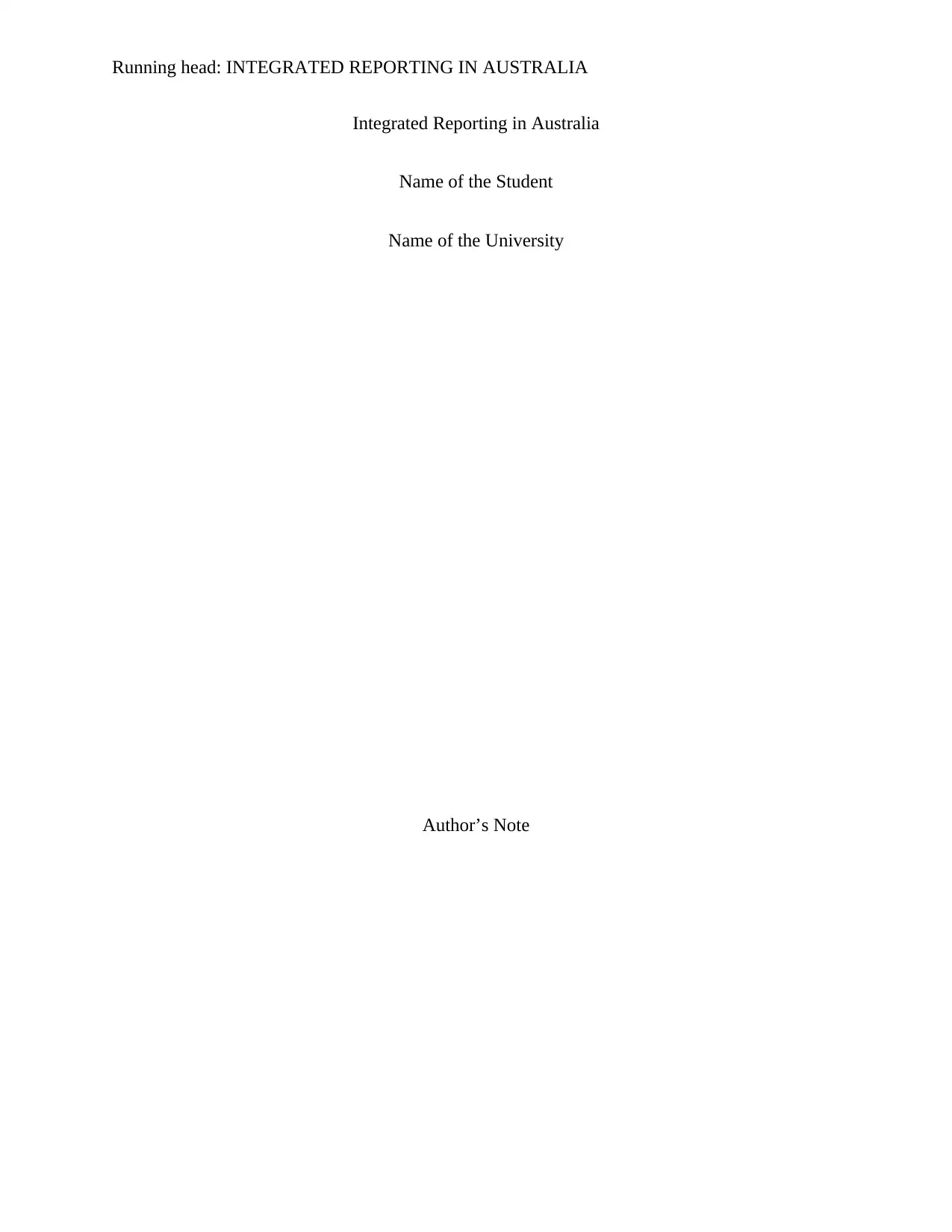
Running head: INTEGRATED REPORTING IN AUSTRALIA
Integrated Reporting in Australia
Name of the Student
Name of the University
Author’s Note
Integrated Reporting in Australia
Name of the Student
Name of the University
Author’s Note
Paraphrase This Document
Need a fresh take? Get an instant paraphrase of this document with our AI Paraphraser
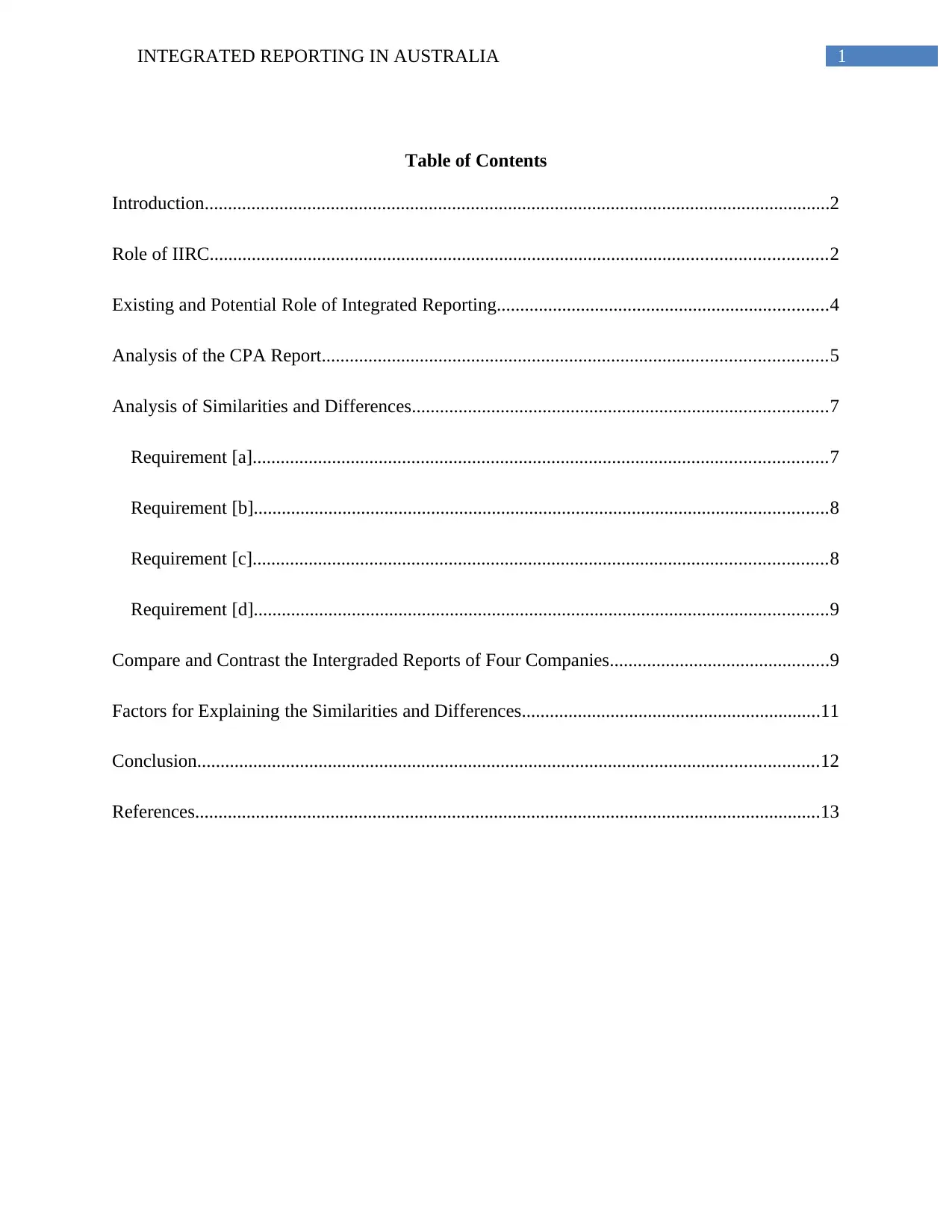
1INTEGRATED REPORTING IN AUSTRALIA
Table of Contents
Introduction......................................................................................................................................2
Role of IIRC....................................................................................................................................2
Existing and Potential Role of Integrated Reporting.......................................................................4
Analysis of the CPA Report............................................................................................................5
Analysis of Similarities and Differences.........................................................................................7
Requirement [a]...........................................................................................................................7
Requirement [b]...........................................................................................................................8
Requirement [c]...........................................................................................................................8
Requirement [d]...........................................................................................................................9
Compare and Contrast the Intergraded Reports of Four Companies...............................................9
Factors for Explaining the Similarities and Differences................................................................11
Conclusion.....................................................................................................................................12
References......................................................................................................................................13
Table of Contents
Introduction......................................................................................................................................2
Role of IIRC....................................................................................................................................2
Existing and Potential Role of Integrated Reporting.......................................................................4
Analysis of the CPA Report............................................................................................................5
Analysis of Similarities and Differences.........................................................................................7
Requirement [a]...........................................................................................................................7
Requirement [b]...........................................................................................................................8
Requirement [c]...........................................................................................................................8
Requirement [d]...........................................................................................................................9
Compare and Contrast the Intergraded Reports of Four Companies...............................................9
Factors for Explaining the Similarities and Differences................................................................11
Conclusion.....................................................................................................................................12
References......................................................................................................................................13
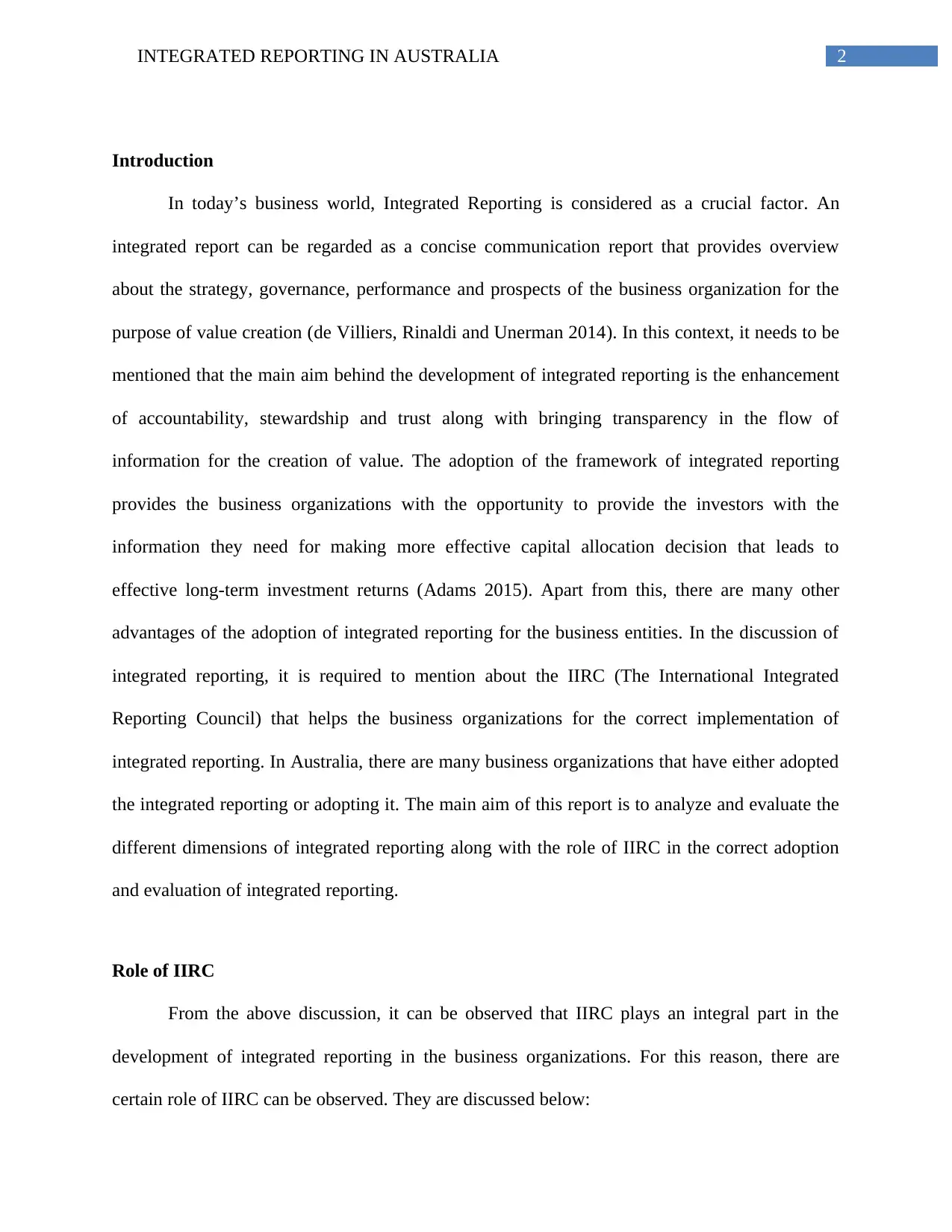
2INTEGRATED REPORTING IN AUSTRALIA
Introduction
In today’s business world, Integrated Reporting is considered as a crucial factor. An
integrated report can be regarded as a concise communication report that provides overview
about the strategy, governance, performance and prospects of the business organization for the
purpose of value creation (de Villiers, Rinaldi and Unerman 2014). In this context, it needs to be
mentioned that the main aim behind the development of integrated reporting is the enhancement
of accountability, stewardship and trust along with bringing transparency in the flow of
information for the creation of value. The adoption of the framework of integrated reporting
provides the business organizations with the opportunity to provide the investors with the
information they need for making more effective capital allocation decision that leads to
effective long-term investment returns (Adams 2015). Apart from this, there are many other
advantages of the adoption of integrated reporting for the business entities. In the discussion of
integrated reporting, it is required to mention about the IIRC (The International Integrated
Reporting Council) that helps the business organizations for the correct implementation of
integrated reporting. In Australia, there are many business organizations that have either adopted
the integrated reporting or adopting it. The main aim of this report is to analyze and evaluate the
different dimensions of integrated reporting along with the role of IIRC in the correct adoption
and evaluation of integrated reporting.
Role of IIRC
From the above discussion, it can be observed that IIRC plays an integral part in the
development of integrated reporting in the business organizations. For this reason, there are
certain role of IIRC can be observed. They are discussed below:
Introduction
In today’s business world, Integrated Reporting is considered as a crucial factor. An
integrated report can be regarded as a concise communication report that provides overview
about the strategy, governance, performance and prospects of the business organization for the
purpose of value creation (de Villiers, Rinaldi and Unerman 2014). In this context, it needs to be
mentioned that the main aim behind the development of integrated reporting is the enhancement
of accountability, stewardship and trust along with bringing transparency in the flow of
information for the creation of value. The adoption of the framework of integrated reporting
provides the business organizations with the opportunity to provide the investors with the
information they need for making more effective capital allocation decision that leads to
effective long-term investment returns (Adams 2015). Apart from this, there are many other
advantages of the adoption of integrated reporting for the business entities. In the discussion of
integrated reporting, it is required to mention about the IIRC (The International Integrated
Reporting Council) that helps the business organizations for the correct implementation of
integrated reporting. In Australia, there are many business organizations that have either adopted
the integrated reporting or adopting it. The main aim of this report is to analyze and evaluate the
different dimensions of integrated reporting along with the role of IIRC in the correct adoption
and evaluation of integrated reporting.
Role of IIRC
From the above discussion, it can be observed that IIRC plays an integral part in the
development of integrated reporting in the business organizations. For this reason, there are
certain role of IIRC can be observed. They are discussed below:
⊘ This is a preview!⊘
Do you want full access?
Subscribe today to unlock all pages.

Trusted by 1+ million students worldwide
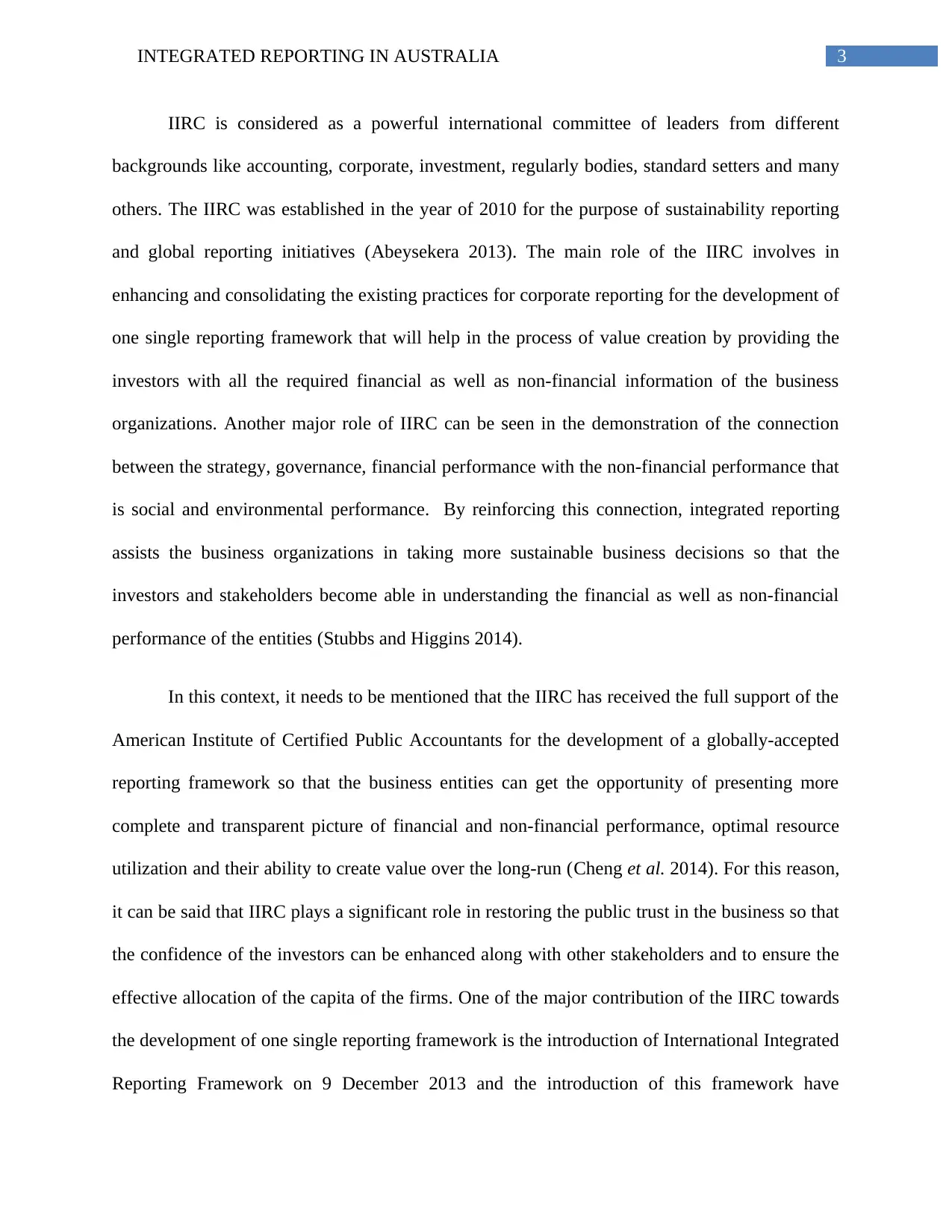
3INTEGRATED REPORTING IN AUSTRALIA
IIRC is considered as a powerful international committee of leaders from different
backgrounds like accounting, corporate, investment, regularly bodies, standard setters and many
others. The IIRC was established in the year of 2010 for the purpose of sustainability reporting
and global reporting initiatives (Abeysekera 2013). The main role of the IIRC involves in
enhancing and consolidating the existing practices for corporate reporting for the development of
one single reporting framework that will help in the process of value creation by providing the
investors with all the required financial as well as non-financial information of the business
organizations. Another major role of IIRC can be seen in the demonstration of the connection
between the strategy, governance, financial performance with the non-financial performance that
is social and environmental performance. By reinforcing this connection, integrated reporting
assists the business organizations in taking more sustainable business decisions so that the
investors and stakeholders become able in understanding the financial as well as non-financial
performance of the entities (Stubbs and Higgins 2014).
In this context, it needs to be mentioned that the IIRC has received the full support of the
American Institute of Certified Public Accountants for the development of a globally-accepted
reporting framework so that the business entities can get the opportunity of presenting more
complete and transparent picture of financial and non-financial performance, optimal resource
utilization and their ability to create value over the long-run (Cheng et al. 2014). For this reason,
it can be said that IIRC plays a significant role in restoring the public trust in the business so that
the confidence of the investors can be enhanced along with other stakeholders and to ensure the
effective allocation of the capita of the firms. One of the major contribution of the IIRC towards
the development of one single reporting framework is the introduction of International Integrated
Reporting Framework on 9 December 2013 and the introduction of this framework have
IIRC is considered as a powerful international committee of leaders from different
backgrounds like accounting, corporate, investment, regularly bodies, standard setters and many
others. The IIRC was established in the year of 2010 for the purpose of sustainability reporting
and global reporting initiatives (Abeysekera 2013). The main role of the IIRC involves in
enhancing and consolidating the existing practices for corporate reporting for the development of
one single reporting framework that will help in the process of value creation by providing the
investors with all the required financial as well as non-financial information of the business
organizations. Another major role of IIRC can be seen in the demonstration of the connection
between the strategy, governance, financial performance with the non-financial performance that
is social and environmental performance. By reinforcing this connection, integrated reporting
assists the business organizations in taking more sustainable business decisions so that the
investors and stakeholders become able in understanding the financial as well as non-financial
performance of the entities (Stubbs and Higgins 2014).
In this context, it needs to be mentioned that the IIRC has received the full support of the
American Institute of Certified Public Accountants for the development of a globally-accepted
reporting framework so that the business entities can get the opportunity of presenting more
complete and transparent picture of financial and non-financial performance, optimal resource
utilization and their ability to create value over the long-run (Cheng et al. 2014). For this reason,
it can be said that IIRC plays a significant role in restoring the public trust in the business so that
the confidence of the investors can be enhanced along with other stakeholders and to ensure the
effective allocation of the capita of the firms. One of the major contribution of the IIRC towards
the development of one single reporting framework is the introduction of International Integrated
Reporting Framework on 9 December 2013 and the introduction of this framework have
Paraphrase This Document
Need a fresh take? Get an instant paraphrase of this document with our AI Paraphraser
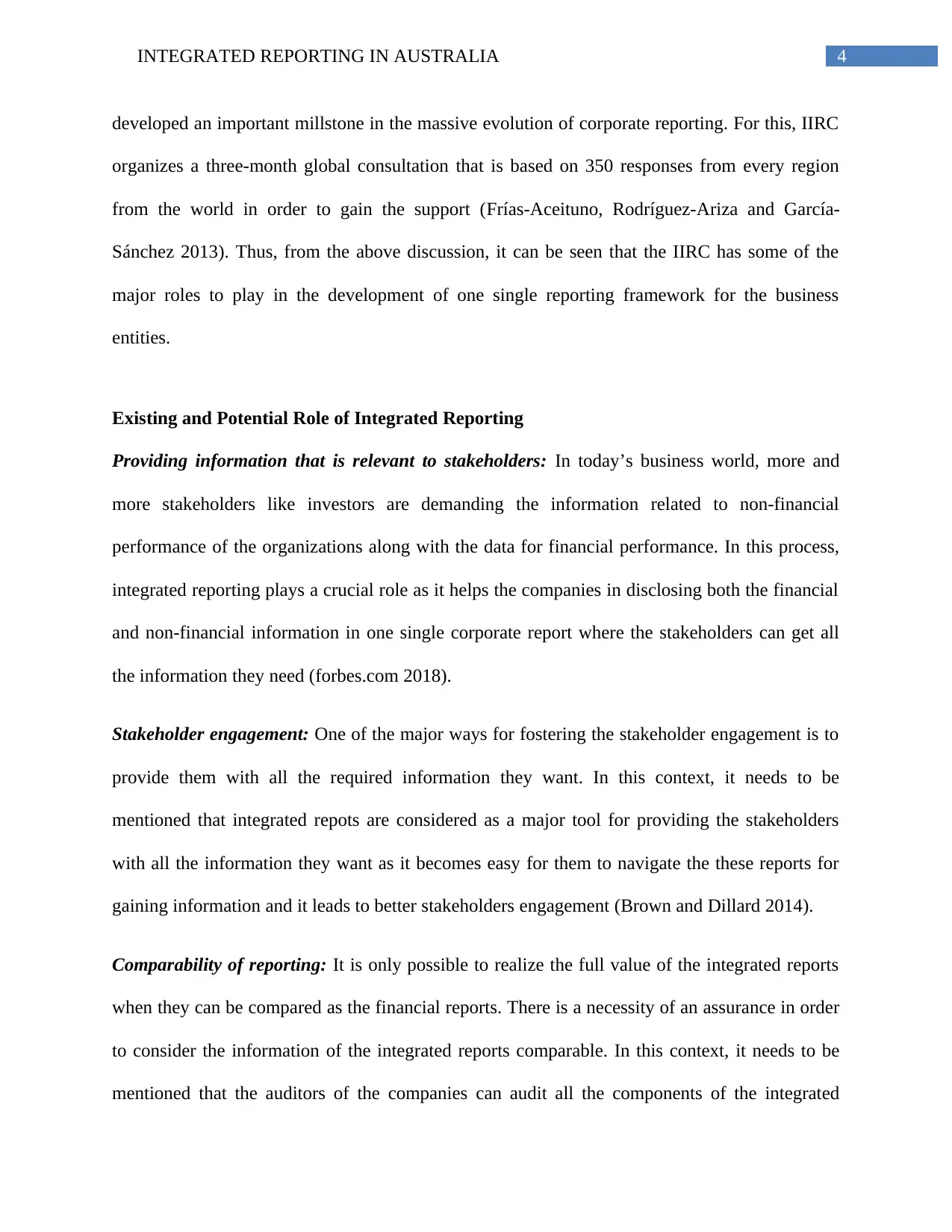
4INTEGRATED REPORTING IN AUSTRALIA
developed an important millstone in the massive evolution of corporate reporting. For this, IIRC
organizes a three-month global consultation that is based on 350 responses from every region
from the world in order to gain the support (Frías-Aceituno, Rodríguez-Ariza and García-
Sánchez 2013). Thus, from the above discussion, it can be seen that the IIRC has some of the
major roles to play in the development of one single reporting framework for the business
entities.
Existing and Potential Role of Integrated Reporting
Providing information that is relevant to stakeholders: In today’s business world, more and
more stakeholders like investors are demanding the information related to non-financial
performance of the organizations along with the data for financial performance. In this process,
integrated reporting plays a crucial role as it helps the companies in disclosing both the financial
and non-financial information in one single corporate report where the stakeholders can get all
the information they need (forbes.com 2018).
Stakeholder engagement: One of the major ways for fostering the stakeholder engagement is to
provide them with all the required information they want. In this context, it needs to be
mentioned that integrated repots are considered as a major tool for providing the stakeholders
with all the information they want as it becomes easy for them to navigate the these reports for
gaining information and it leads to better stakeholders engagement (Brown and Dillard 2014).
Comparability of reporting: It is only possible to realize the full value of the integrated reports
when they can be compared as the financial reports. There is a necessity of an assurance in order
to consider the information of the integrated reports comparable. In this context, it needs to be
mentioned that the auditors of the companies can audit all the components of the integrated
developed an important millstone in the massive evolution of corporate reporting. For this, IIRC
organizes a three-month global consultation that is based on 350 responses from every region
from the world in order to gain the support (Frías-Aceituno, Rodríguez-Ariza and García-
Sánchez 2013). Thus, from the above discussion, it can be seen that the IIRC has some of the
major roles to play in the development of one single reporting framework for the business
entities.
Existing and Potential Role of Integrated Reporting
Providing information that is relevant to stakeholders: In today’s business world, more and
more stakeholders like investors are demanding the information related to non-financial
performance of the organizations along with the data for financial performance. In this process,
integrated reporting plays a crucial role as it helps the companies in disclosing both the financial
and non-financial information in one single corporate report where the stakeholders can get all
the information they need (forbes.com 2018).
Stakeholder engagement: One of the major ways for fostering the stakeholder engagement is to
provide them with all the required information they want. In this context, it needs to be
mentioned that integrated repots are considered as a major tool for providing the stakeholders
with all the information they want as it becomes easy for them to navigate the these reports for
gaining information and it leads to better stakeholders engagement (Brown and Dillard 2014).
Comparability of reporting: It is only possible to realize the full value of the integrated reports
when they can be compared as the financial reports. There is a necessity of an assurance in order
to consider the information of the integrated reports comparable. In this context, it needs to be
mentioned that the auditors of the companies can audit all the components of the integrated
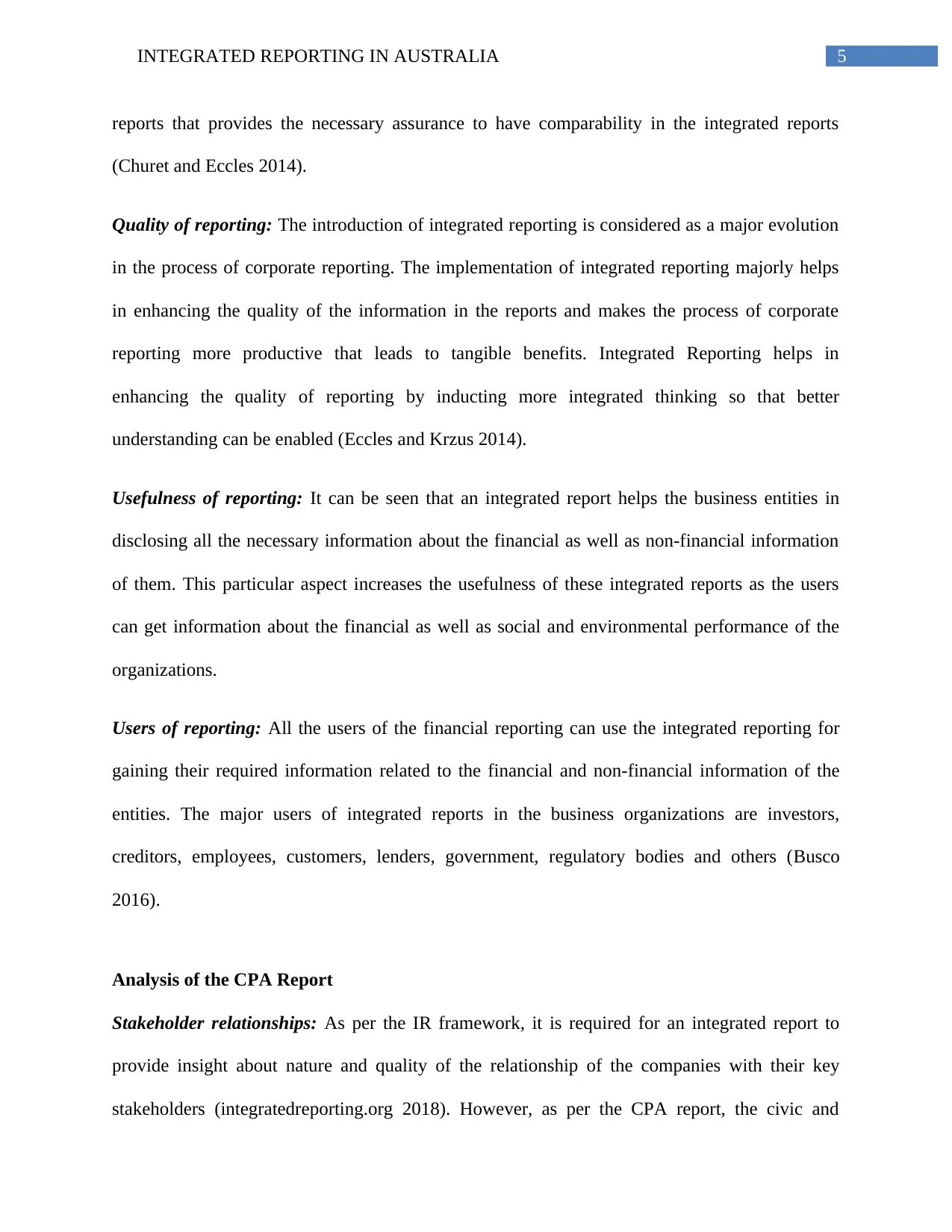
5INTEGRATED REPORTING IN AUSTRALIA
reports that provides the necessary assurance to have comparability in the integrated reports
(Churet and Eccles 2014).
Quality of reporting: The introduction of integrated reporting is considered as a major evolution
in the process of corporate reporting. The implementation of integrated reporting majorly helps
in enhancing the quality of the information in the reports and makes the process of corporate
reporting more productive that leads to tangible benefits. Integrated Reporting helps in
enhancing the quality of reporting by inducting more integrated thinking so that better
understanding can be enabled (Eccles and Krzus 2014).
Usefulness of reporting: It can be seen that an integrated report helps the business entities in
disclosing all the necessary information about the financial as well as non-financial information
of them. This particular aspect increases the usefulness of these integrated reports as the users
can get information about the financial as well as social and environmental performance of the
organizations.
Users of reporting: All the users of the financial reporting can use the integrated reporting for
gaining their required information related to the financial and non-financial information of the
entities. The major users of integrated reports in the business organizations are investors,
creditors, employees, customers, lenders, government, regulatory bodies and others (Busco
2016).
Analysis of the CPA Report
Stakeholder relationships: As per the IR framework, it is required for an integrated report to
provide insight about nature and quality of the relationship of the companies with their key
stakeholders (integratedreporting.org 2018). However, as per the CPA report, the civic and
reports that provides the necessary assurance to have comparability in the integrated reports
(Churet and Eccles 2014).
Quality of reporting: The introduction of integrated reporting is considered as a major evolution
in the process of corporate reporting. The implementation of integrated reporting majorly helps
in enhancing the quality of the information in the reports and makes the process of corporate
reporting more productive that leads to tangible benefits. Integrated Reporting helps in
enhancing the quality of reporting by inducting more integrated thinking so that better
understanding can be enabled (Eccles and Krzus 2014).
Usefulness of reporting: It can be seen that an integrated report helps the business entities in
disclosing all the necessary information about the financial as well as non-financial information
of them. This particular aspect increases the usefulness of these integrated reports as the users
can get information about the financial as well as social and environmental performance of the
organizations.
Users of reporting: All the users of the financial reporting can use the integrated reporting for
gaining their required information related to the financial and non-financial information of the
entities. The major users of integrated reports in the business organizations are investors,
creditors, employees, customers, lenders, government, regulatory bodies and others (Busco
2016).
Analysis of the CPA Report
Stakeholder relationships: As per the IR framework, it is required for an integrated report to
provide insight about nature and quality of the relationship of the companies with their key
stakeholders (integratedreporting.org 2018). However, as per the CPA report, the civic and
⊘ This is a preview!⊘
Do you want full access?
Subscribe today to unlock all pages.

Trusted by 1+ million students worldwide
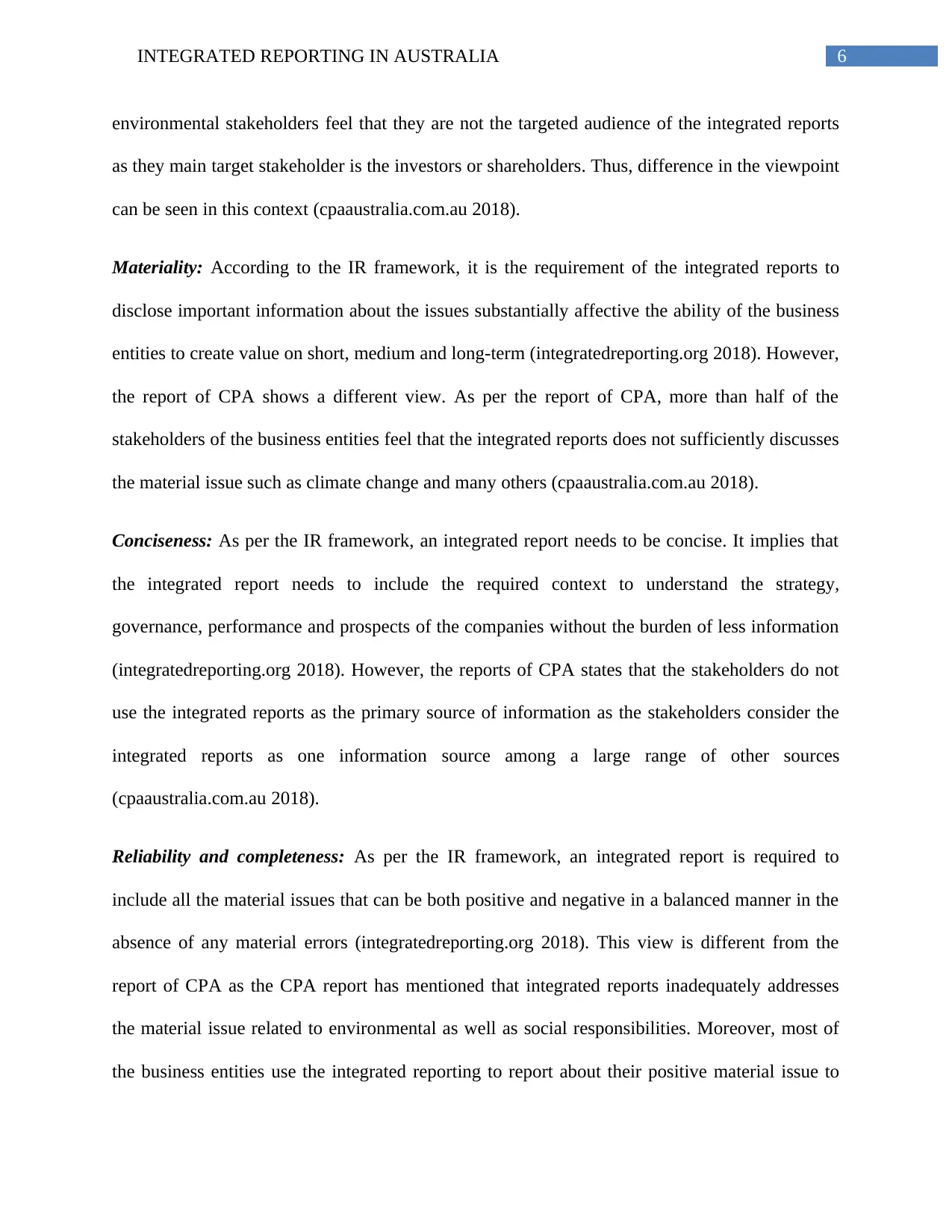
6INTEGRATED REPORTING IN AUSTRALIA
environmental stakeholders feel that they are not the targeted audience of the integrated reports
as they main target stakeholder is the investors or shareholders. Thus, difference in the viewpoint
can be seen in this context (cpaaustralia.com.au 2018).
Materiality: According to the IR framework, it is the requirement of the integrated reports to
disclose important information about the issues substantially affective the ability of the business
entities to create value on short, medium and long-term (integratedreporting.org 2018). However,
the report of CPA shows a different view. As per the report of CPA, more than half of the
stakeholders of the business entities feel that the integrated reports does not sufficiently discusses
the material issue such as climate change and many others (cpaaustralia.com.au 2018).
Conciseness: As per the IR framework, an integrated report needs to be concise. It implies that
the integrated report needs to include the required context to understand the strategy,
governance, performance and prospects of the companies without the burden of less information
(integratedreporting.org 2018). However, the reports of CPA states that the stakeholders do not
use the integrated reports as the primary source of information as the stakeholders consider the
integrated reports as one information source among a large range of other sources
(cpaaustralia.com.au 2018).
Reliability and completeness: As per the IR framework, an integrated report is required to
include all the material issues that can be both positive and negative in a balanced manner in the
absence of any material errors (integratedreporting.org 2018). This view is different from the
report of CPA as the CPA report has mentioned that integrated reports inadequately addresses
the material issue related to environmental as well as social responsibilities. Moreover, most of
the business entities use the integrated reporting to report about their positive material issue to
environmental stakeholders feel that they are not the targeted audience of the integrated reports
as they main target stakeholder is the investors or shareholders. Thus, difference in the viewpoint
can be seen in this context (cpaaustralia.com.au 2018).
Materiality: According to the IR framework, it is the requirement of the integrated reports to
disclose important information about the issues substantially affective the ability of the business
entities to create value on short, medium and long-term (integratedreporting.org 2018). However,
the report of CPA shows a different view. As per the report of CPA, more than half of the
stakeholders of the business entities feel that the integrated reports does not sufficiently discusses
the material issue such as climate change and many others (cpaaustralia.com.au 2018).
Conciseness: As per the IR framework, an integrated report needs to be concise. It implies that
the integrated report needs to include the required context to understand the strategy,
governance, performance and prospects of the companies without the burden of less information
(integratedreporting.org 2018). However, the reports of CPA states that the stakeholders do not
use the integrated reports as the primary source of information as the stakeholders consider the
integrated reports as one information source among a large range of other sources
(cpaaustralia.com.au 2018).
Reliability and completeness: As per the IR framework, an integrated report is required to
include all the material issues that can be both positive and negative in a balanced manner in the
absence of any material errors (integratedreporting.org 2018). This view is different from the
report of CPA as the CPA report has mentioned that integrated reports inadequately addresses
the material issue related to environmental as well as social responsibilities. Moreover, most of
the business entities use the integrated reporting to report about their positive material issue to
Paraphrase This Document
Need a fresh take? Get an instant paraphrase of this document with our AI Paraphraser
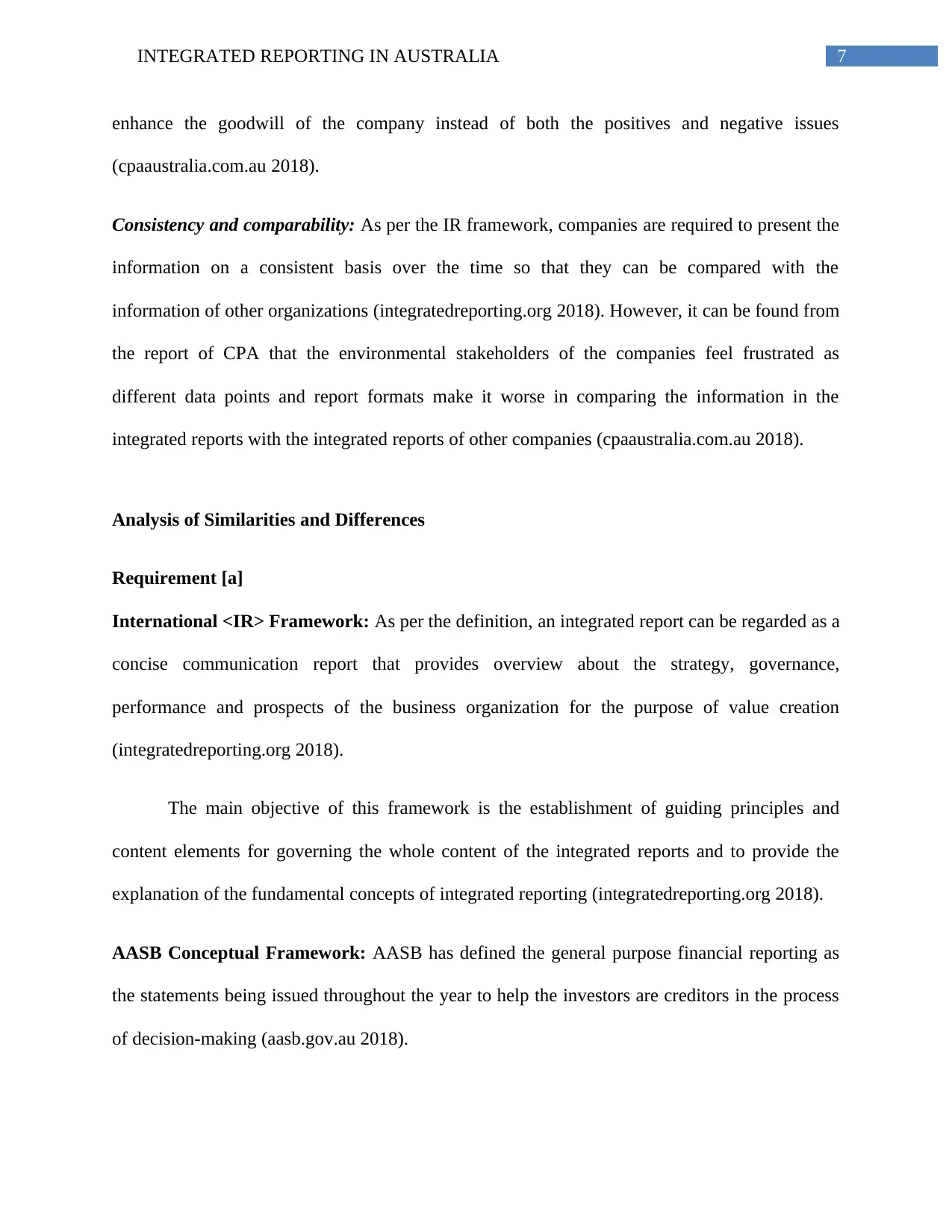
7INTEGRATED REPORTING IN AUSTRALIA
enhance the goodwill of the company instead of both the positives and negative issues
(cpaaustralia.com.au 2018).
Consistency and comparability: As per the IR framework, companies are required to present the
information on a consistent basis over the time so that they can be compared with the
information of other organizations (integratedreporting.org 2018). However, it can be found from
the report of CPA that the environmental stakeholders of the companies feel frustrated as
different data points and report formats make it worse in comparing the information in the
integrated reports with the integrated reports of other companies (cpaaustralia.com.au 2018).
Analysis of Similarities and Differences
Requirement [a]
International <IR> Framework: As per the definition, an integrated report can be regarded as a
concise communication report that provides overview about the strategy, governance,
performance and prospects of the business organization for the purpose of value creation
(integratedreporting.org 2018).
The main objective of this framework is the establishment of guiding principles and
content elements for governing the whole content of the integrated reports and to provide the
explanation of the fundamental concepts of integrated reporting (integratedreporting.org 2018).
AASB Conceptual Framework: AASB has defined the general purpose financial reporting as
the statements being issued throughout the year to help the investors are creditors in the process
of decision-making (aasb.gov.au 2018).
enhance the goodwill of the company instead of both the positives and negative issues
(cpaaustralia.com.au 2018).
Consistency and comparability: As per the IR framework, companies are required to present the
information on a consistent basis over the time so that they can be compared with the
information of other organizations (integratedreporting.org 2018). However, it can be found from
the report of CPA that the environmental stakeholders of the companies feel frustrated as
different data points and report formats make it worse in comparing the information in the
integrated reports with the integrated reports of other companies (cpaaustralia.com.au 2018).
Analysis of Similarities and Differences
Requirement [a]
International <IR> Framework: As per the definition, an integrated report can be regarded as a
concise communication report that provides overview about the strategy, governance,
performance and prospects of the business organization for the purpose of value creation
(integratedreporting.org 2018).
The main objective of this framework is the establishment of guiding principles and
content elements for governing the whole content of the integrated reports and to provide the
explanation of the fundamental concepts of integrated reporting (integratedreporting.org 2018).
AASB Conceptual Framework: AASB has defined the general purpose financial reporting as
the statements being issued throughout the year to help the investors are creditors in the process
of decision-making (aasb.gov.au 2018).
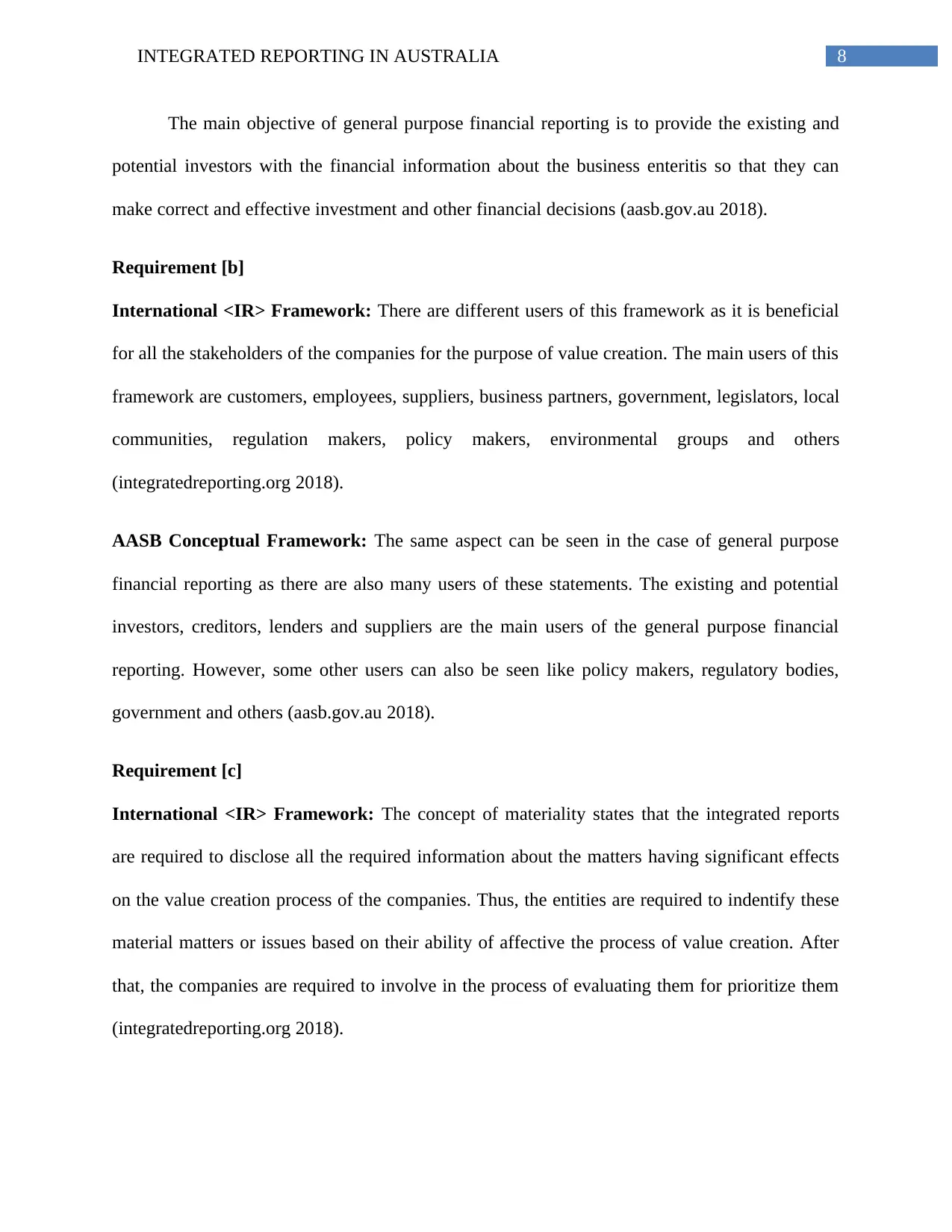
8INTEGRATED REPORTING IN AUSTRALIA
The main objective of general purpose financial reporting is to provide the existing and
potential investors with the financial information about the business enteritis so that they can
make correct and effective investment and other financial decisions (aasb.gov.au 2018).
Requirement [b]
International <IR> Framework: There are different users of this framework as it is beneficial
for all the stakeholders of the companies for the purpose of value creation. The main users of this
framework are customers, employees, suppliers, business partners, government, legislators, local
communities, regulation makers, policy makers, environmental groups and others
(integratedreporting.org 2018).
AASB Conceptual Framework: The same aspect can be seen in the case of general purpose
financial reporting as there are also many users of these statements. The existing and potential
investors, creditors, lenders and suppliers are the main users of the general purpose financial
reporting. However, some other users can also be seen like policy makers, regulatory bodies,
government and others (aasb.gov.au 2018).
Requirement [c]
International <IR> Framework: The concept of materiality states that the integrated reports
are required to disclose all the required information about the matters having significant effects
on the value creation process of the companies. Thus, the entities are required to indentify these
material matters or issues based on their ability of affective the process of value creation. After
that, the companies are required to involve in the process of evaluating them for prioritize them
(integratedreporting.org 2018).
The main objective of general purpose financial reporting is to provide the existing and
potential investors with the financial information about the business enteritis so that they can
make correct and effective investment and other financial decisions (aasb.gov.au 2018).
Requirement [b]
International <IR> Framework: There are different users of this framework as it is beneficial
for all the stakeholders of the companies for the purpose of value creation. The main users of this
framework are customers, employees, suppliers, business partners, government, legislators, local
communities, regulation makers, policy makers, environmental groups and others
(integratedreporting.org 2018).
AASB Conceptual Framework: The same aspect can be seen in the case of general purpose
financial reporting as there are also many users of these statements. The existing and potential
investors, creditors, lenders and suppliers are the main users of the general purpose financial
reporting. However, some other users can also be seen like policy makers, regulatory bodies,
government and others (aasb.gov.au 2018).
Requirement [c]
International <IR> Framework: The concept of materiality states that the integrated reports
are required to disclose all the required information about the matters having significant effects
on the value creation process of the companies. Thus, the entities are required to indentify these
material matters or issues based on their ability of affective the process of value creation. After
that, the companies are required to involve in the process of evaluating them for prioritize them
(integratedreporting.org 2018).
⊘ This is a preview!⊘
Do you want full access?
Subscribe today to unlock all pages.

Trusted by 1+ million students worldwide
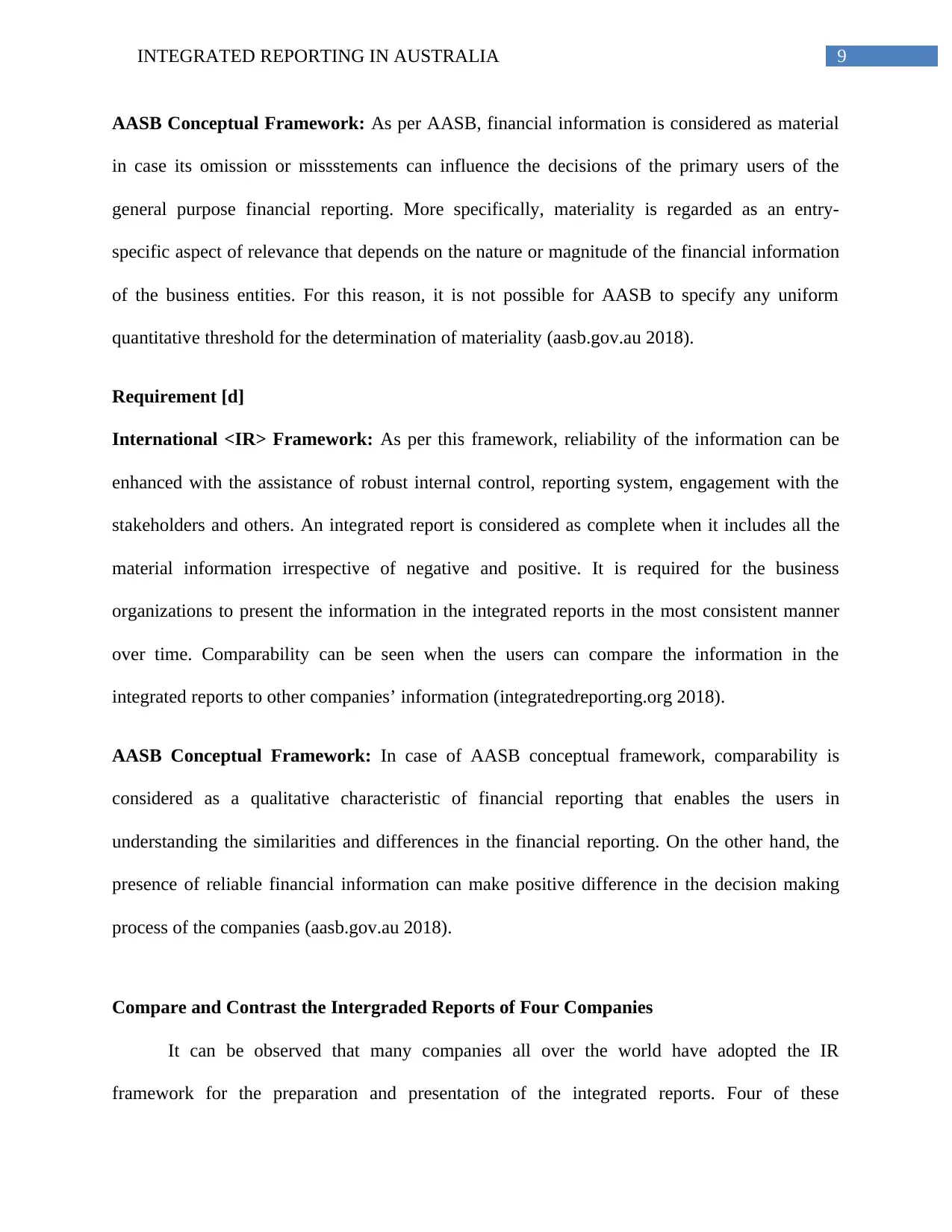
9INTEGRATED REPORTING IN AUSTRALIA
AASB Conceptual Framework: As per AASB, financial information is considered as material
in case its omission or missstements can influence the decisions of the primary users of the
general purpose financial reporting. More specifically, materiality is regarded as an entry-
specific aspect of relevance that depends on the nature or magnitude of the financial information
of the business entities. For this reason, it is not possible for AASB to specify any uniform
quantitative threshold for the determination of materiality (aasb.gov.au 2018).
Requirement [d]
International <IR> Framework: As per this framework, reliability of the information can be
enhanced with the assistance of robust internal control, reporting system, engagement with the
stakeholders and others. An integrated report is considered as complete when it includes all the
material information irrespective of negative and positive. It is required for the business
organizations to present the information in the integrated reports in the most consistent manner
over time. Comparability can be seen when the users can compare the information in the
integrated reports to other companies’ information (integratedreporting.org 2018).
AASB Conceptual Framework: In case of AASB conceptual framework, comparability is
considered as a qualitative characteristic of financial reporting that enables the users in
understanding the similarities and differences in the financial reporting. On the other hand, the
presence of reliable financial information can make positive difference in the decision making
process of the companies (aasb.gov.au 2018).
Compare and Contrast the Intergraded Reports of Four Companies
It can be observed that many companies all over the world have adopted the IR
framework for the preparation and presentation of the integrated reports. Four of these
AASB Conceptual Framework: As per AASB, financial information is considered as material
in case its omission or missstements can influence the decisions of the primary users of the
general purpose financial reporting. More specifically, materiality is regarded as an entry-
specific aspect of relevance that depends on the nature or magnitude of the financial information
of the business entities. For this reason, it is not possible for AASB to specify any uniform
quantitative threshold for the determination of materiality (aasb.gov.au 2018).
Requirement [d]
International <IR> Framework: As per this framework, reliability of the information can be
enhanced with the assistance of robust internal control, reporting system, engagement with the
stakeholders and others. An integrated report is considered as complete when it includes all the
material information irrespective of negative and positive. It is required for the business
organizations to present the information in the integrated reports in the most consistent manner
over time. Comparability can be seen when the users can compare the information in the
integrated reports to other companies’ information (integratedreporting.org 2018).
AASB Conceptual Framework: In case of AASB conceptual framework, comparability is
considered as a qualitative characteristic of financial reporting that enables the users in
understanding the similarities and differences in the financial reporting. On the other hand, the
presence of reliable financial information can make positive difference in the decision making
process of the companies (aasb.gov.au 2018).
Compare and Contrast the Intergraded Reports of Four Companies
It can be observed that many companies all over the world have adopted the IR
framework for the preparation and presentation of the integrated reports. Four of these
Paraphrase This Document
Need a fresh take? Get an instant paraphrase of this document with our AI Paraphraser
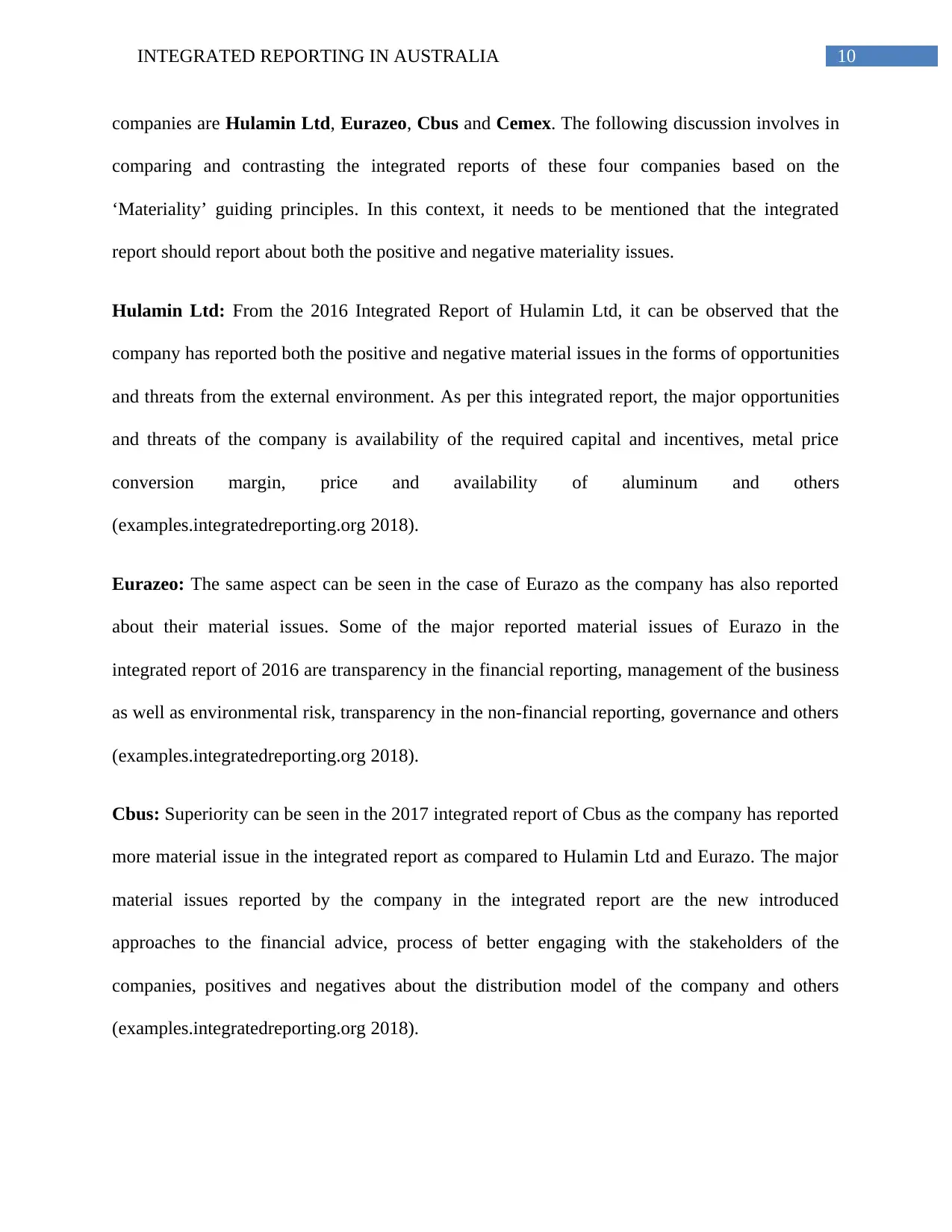
10INTEGRATED REPORTING IN AUSTRALIA
companies are Hulamin Ltd, Eurazeo, Cbus and Cemex. The following discussion involves in
comparing and contrasting the integrated reports of these four companies based on the
‘Materiality’ guiding principles. In this context, it needs to be mentioned that the integrated
report should report about both the positive and negative materiality issues.
Hulamin Ltd: From the 2016 Integrated Report of Hulamin Ltd, it can be observed that the
company has reported both the positive and negative material issues in the forms of opportunities
and threats from the external environment. As per this integrated report, the major opportunities
and threats of the company is availability of the required capital and incentives, metal price
conversion margin, price and availability of aluminum and others
(examples.integratedreporting.org 2018).
Eurazeo: The same aspect can be seen in the case of Eurazo as the company has also reported
about their material issues. Some of the major reported material issues of Eurazo in the
integrated report of 2016 are transparency in the financial reporting, management of the business
as well as environmental risk, transparency in the non-financial reporting, governance and others
(examples.integratedreporting.org 2018).
Cbus: Superiority can be seen in the 2017 integrated report of Cbus as the company has reported
more material issue in the integrated report as compared to Hulamin Ltd and Eurazo. The major
material issues reported by the company in the integrated report are the new introduced
approaches to the financial advice, process of better engaging with the stakeholders of the
companies, positives and negatives about the distribution model of the company and others
(examples.integratedreporting.org 2018).
companies are Hulamin Ltd, Eurazeo, Cbus and Cemex. The following discussion involves in
comparing and contrasting the integrated reports of these four companies based on the
‘Materiality’ guiding principles. In this context, it needs to be mentioned that the integrated
report should report about both the positive and negative materiality issues.
Hulamin Ltd: From the 2016 Integrated Report of Hulamin Ltd, it can be observed that the
company has reported both the positive and negative material issues in the forms of opportunities
and threats from the external environment. As per this integrated report, the major opportunities
and threats of the company is availability of the required capital and incentives, metal price
conversion margin, price and availability of aluminum and others
(examples.integratedreporting.org 2018).
Eurazeo: The same aspect can be seen in the case of Eurazo as the company has also reported
about their material issues. Some of the major reported material issues of Eurazo in the
integrated report of 2016 are transparency in the financial reporting, management of the business
as well as environmental risk, transparency in the non-financial reporting, governance and others
(examples.integratedreporting.org 2018).
Cbus: Superiority can be seen in the 2017 integrated report of Cbus as the company has reported
more material issue in the integrated report as compared to Hulamin Ltd and Eurazo. The major
material issues reported by the company in the integrated report are the new introduced
approaches to the financial advice, process of better engaging with the stakeholders of the
companies, positives and negatives about the distribution model of the company and others
(examples.integratedreporting.org 2018).
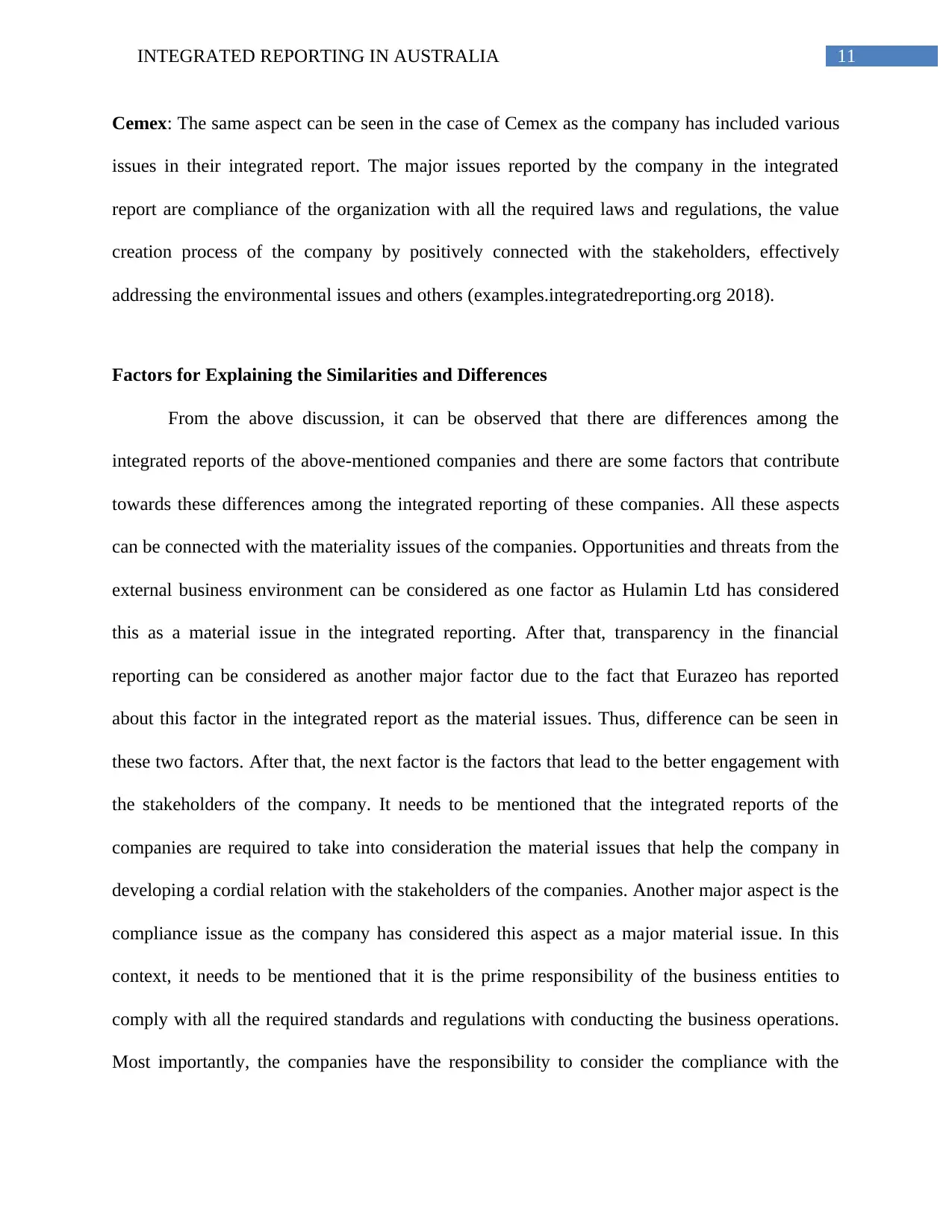
11INTEGRATED REPORTING IN AUSTRALIA
Cemex: The same aspect can be seen in the case of Cemex as the company has included various
issues in their integrated report. The major issues reported by the company in the integrated
report are compliance of the organization with all the required laws and regulations, the value
creation process of the company by positively connected with the stakeholders, effectively
addressing the environmental issues and others (examples.integratedreporting.org 2018).
Factors for Explaining the Similarities and Differences
From the above discussion, it can be observed that there are differences among the
integrated reports of the above-mentioned companies and there are some factors that contribute
towards these differences among the integrated reporting of these companies. All these aspects
can be connected with the materiality issues of the companies. Opportunities and threats from the
external business environment can be considered as one factor as Hulamin Ltd has considered
this as a material issue in the integrated reporting. After that, transparency in the financial
reporting can be considered as another major factor due to the fact that Eurazeo has reported
about this factor in the integrated report as the material issues. Thus, difference can be seen in
these two factors. After that, the next factor is the factors that lead to the better engagement with
the stakeholders of the company. It needs to be mentioned that the integrated reports of the
companies are required to take into consideration the material issues that help the company in
developing a cordial relation with the stakeholders of the companies. Another major aspect is the
compliance issue as the company has considered this aspect as a major material issue. In this
context, it needs to be mentioned that it is the prime responsibility of the business entities to
comply with all the required standards and regulations with conducting the business operations.
Most importantly, the companies have the responsibility to consider the compliance with the
Cemex: The same aspect can be seen in the case of Cemex as the company has included various
issues in their integrated report. The major issues reported by the company in the integrated
report are compliance of the organization with all the required laws and regulations, the value
creation process of the company by positively connected with the stakeholders, effectively
addressing the environmental issues and others (examples.integratedreporting.org 2018).
Factors for Explaining the Similarities and Differences
From the above discussion, it can be observed that there are differences among the
integrated reports of the above-mentioned companies and there are some factors that contribute
towards these differences among the integrated reporting of these companies. All these aspects
can be connected with the materiality issues of the companies. Opportunities and threats from the
external business environment can be considered as one factor as Hulamin Ltd has considered
this as a material issue in the integrated reporting. After that, transparency in the financial
reporting can be considered as another major factor due to the fact that Eurazeo has reported
about this factor in the integrated report as the material issues. Thus, difference can be seen in
these two factors. After that, the next factor is the factors that lead to the better engagement with
the stakeholders of the company. It needs to be mentioned that the integrated reports of the
companies are required to take into consideration the material issues that help the company in
developing a cordial relation with the stakeholders of the companies. Another major aspect is the
compliance issue as the company has considered this aspect as a major material issue. In this
context, it needs to be mentioned that it is the prime responsibility of the business entities to
comply with all the required standards and regulations with conducting the business operations.
Most importantly, the companies have the responsibility to consider the compliance with the
⊘ This is a preview!⊘
Do you want full access?
Subscribe today to unlock all pages.

Trusted by 1+ million students worldwide
1 out of 16
Related Documents
Your All-in-One AI-Powered Toolkit for Academic Success.
+13062052269
info@desklib.com
Available 24*7 on WhatsApp / Email
![[object Object]](/_next/static/media/star-bottom.7253800d.svg)
Unlock your academic potential
Copyright © 2020–2025 A2Z Services. All Rights Reserved. Developed and managed by ZUCOL.





